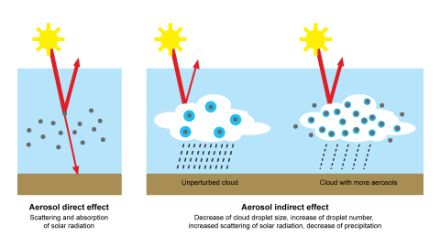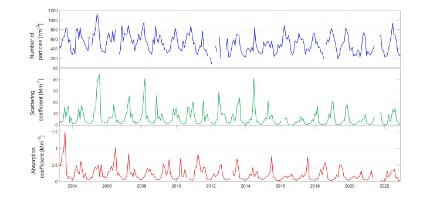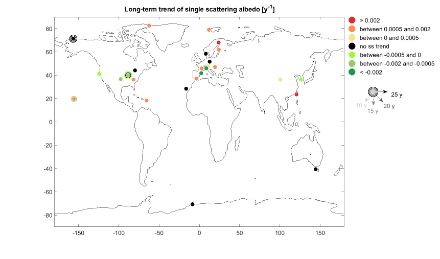Service Navigation
Search
Aerosols are solid or liquid particles suspended in the air and originating from natural processes (soil erosion, sea spray, forest fires, volcanoes, etc.) or anthropogenic processes (combustion of oil, gas, wood, agriculture, traffic, etc.). Although they are harmful to health, they are the only element in the atmosphere that cools the climate. Depending on their chemical composition and size, aerosols reflect solar radiation back into space, thereby reducing ground temperatures.
Aerosols are also necessary for cloud formation. They act as "condensation nuclei": when the air is saturated with water vapour, the water condenses on the surface of the aerosols to form droplets. These droplets grow until they form a dense cloud, triggering precipitation. If we increase the number of aerosols, the clouds will be made up of more numerous but smaller water droplets. The clouds will then be brighter and reflect more solar radiation back into space, which tends to cool the climate through an indirect aerosol effect. In addition, precipitation will decrease as smaller drops remain suspended in the air.
Despite a large margin of uncertainty, it is accepted by the scientific community that aerosols thus contribute to reducing greenhouse gas-induced global warming. However, aerosols have a very short lifespan - a few weeks at most - whereas greenhouse gases can remain in the atmosphere for up to several thousand years.

Aerosol monitoring
In Switzerland, aerosols are measured on the Jungfraujoch (altitude 3,580 m.a.s.l.) for climate research under the auspices of the World Meteorological Organisation’s Global Atmosphere Watch (GAW). The aerosol monitoring programme operated by the Paul Scherrer Institute (PSI) constitutes one of the most comprehensive and longest-running data series of its kind in the world. Due to the high altitude of the station, the Jungfraujoch is partly located in the free troposphere. This zone of the atmosphere is detached from lower part of the atmosphere that is regularly fed with aerosols from natural sources and human activities. This lowest atmospheric layer is called boundary layer, and it is where aerosols tend to accumulate. The Jungfraujoch is situated a considerable distance away from sources of pollution. The long temporal series demonstrates a seasonal cycle for all of the parameters measured. This is primarily due to vertical transport of aerosol-laden air from the boundary layer in the summertime. The air from the boundary layer heats up on hot, sunny days and rises because it is warmer and so can reach high altitudes.


A trend analysis of the scattering and absorption coefficients as well as of the number concentration over the last 10-15 years (Collaud Coen et al., 2020, Asmi et al., 2013) showed a clear decrease of the aerosol load in almost every part of the world. The single scattering albedo is one of the most important parameters describing the aerosol effects on climate. The increase of this parameter from 2009 to 2018, mainly observed in Eastern Europe, Arctic and Asia, means an increase of the capacity of aerosols to cool the climate. In North America and Western Europe, anti-pollution measures aimed at reducing the deleterious effects of aerosol on health have the side effect of reducing the cooling power of aerosols on climate. A low-carbon society is the optimal solution for public health and climate.
Collaud Coen, M. et al.: Multidecadal trend analysis of in situ aerosol radiative properties around the world, Atmos. Chem. Phys., 20, 8867–8908, 2020. Multidecadal trend analysis of in situ aerosol radiative properties around the world”: https://doi.org/10.5194/acp-20-8867-2020
Asmi, A.; Collaud Coen, M.; Ogren, J. A.; Andrews, E.; Sheridan, P.; Jefferson, A.; Weingartner, E.; Baltensperger, U.; Bukowiecki, N.; Lihavainen, H.; Kivekäs, N.; Asmi, E.; Aalto, P. P.; Kulmala, M.; Wiedensohler, A.; Birmili, W.; Hamed, A.; O'Dowd, C.; G Jennings, S.; Weller, R.; Flentje, H.; Fjaeraa, A. M.; Fiebig, M.; Myhre, C. L.; Hallar, A. G.; Swietlicki, E.; Kristensson, A. and Laj, P. Aerosol decadal trends: Part 2: In-situ aerosol particle number concentrations at GAW and ACTRIS stations Atmos. Chem. Phys., 2013, 13, 895-916
Collaud Coen, M., Weingartner, E., Furger, M., Nyeki, S., Prévôt, A.S.H., Steinbacher, M., and Baltensperger, U.: Aerosol climatology and planetary boundary influence at the Jungfraujoch analyzed by synoptic weather types, Atmos. Chem. Phys., 11, 5931-5944, 2011.
Collaud Coen, M., Weingartner, E., Apituley, A., Ceburnis, D., Fierz-Schmidhauser, R., Flentje, H., Henzing, J. S., Jennings, S. G., Moerman, M., Petzold, A. and others: Minimizing light absorption measurement artifacts of the Aethalometer: evaluation of five correction algorithms, Atmos. Meas. Tech., 3, 457-474, 2010.